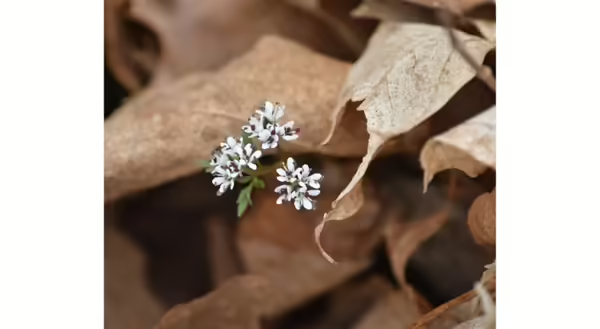
Warming spring weather is often enough motivation to get many of us out looking for the first blooms of the growing season. In my home garden, snow crocus (Crocus sieberi) is about the only plant that has started to show life over recent days, reaching full bloom sometime earlier this week. If your garden is still as bare as mine, our local natural areas are a wonderful place to observe native spring wildflowers and some early performers are already beginning the show for 2020.
The very earliest of our native wildflowers is the aptly named Harbinger-of-Spring (Erigenia bulbosa). Most years, I tend to overlook this minute, inconspicuous white flower until I start the search for another favorite, spring beauties (Claytonia virginica) and happen across it while searching for the latter. This year, one of our local Master Naturalists, Theresa Dewitt, shared some great pictures of harbinger-of-spring earlier this week and it motivated me to get out in nature in search of this tiny presage to the end of winter.
Harbinger-of-spring is actually a member of the parsley or carrot family, sharing traits with other relatives such as Queen Ann’s lace (Daucus carota) or poison hemlock (Conium maculatum), not to mention its culinary cousins such as carrot, parsnip, celery, and dill. This family of aromatic flowering plants is widely distributed globally and quite diverse. However, harbinger-of-spring is the only member of its genus, Erigenia.
Flowers emerge prior to the foliage on tiny stems that barely top the leaf litter layer, but are often up to one foot long, trailing along the surface under leaves. Given the especially small sized flower, they are sometimes hard to see or identify amongst the forest litter layer, requiring close attention to spot them. Flowers are similar to other members of the carrot family, consisting of a complex structure, called an umbel, with anywhere from one to up to twenty-four individual flowers. Flowers emerge ahead of its equally tiny, compound leaves that are quite similar in appearance to parsley. As the flowers develop, tiny anthers in the center of each flower become dark, almost black in color, directly contrasting its white pedals and lending to its other common name, “Salt and Pepper”.
Over the next month, this plant will flower, overlapping with other early emerging wildflowers later in its bloom period. Harbinger-of-Spring is a spring ephemeral wildflower, meaning it completes most all of its above-ground activity each year before tree leaves emerge and the canopy closes creating shade in the understory. Each spring there is steady progression of blooming ephemerals that will continue from now until mid to late May.
These wildflower populations are sensitive to human impacts, making them rare in all but the higher quality woodlands around our state. Woodland plant communities are considered high quality when they have a healthy, diverse canopy of native overstory trees, along with adequate native tree regeneration (seedlings) in the understory, as well as a diverse, native herbaceous layer on the woodland floor. These conditions are often absent in many woodlands due to impacts such as invasive species, overgrazing (by deer or livestock), lack of prescribed fires, lack of overstory diversity, overabundance of shade tolerant species, past mismanagement or lack of planned forest management activities.
In the herbaceous layer, spring ephemeral wildflowers serve as an important early source of nectar for populations of native pollinators with many intricate relationships to the insect life they support in the early season, making them an important part of woodland ecosystems. In return, pollinating insects support wildflower populations by performing the vital service of pollination.
With all the pressures currently threatening spring ephemeral wildflowers, from invasive species and climate change, to more local impacts from human disturbance and habitat destruction, it is vitally important we conserve and protect their populations in the wild.
Many species of native wildflowers, such as spring beauties and bluebells can be grown in cultivation and make a wonderful, native addition to your landscape. I encourage folks to add these plants, not only for their early season beauty, but to support insect life and help to create landscapes that are more representative of our native flora. However, wild harvesting has a detrimental impact to their populations.
If you are interested in establishing these plants in your home landscape, please purchase plant stock or seeds from a reputable source producing these plants in cultivation, as opposed to harvesting from wild populations. There are a number of reputable online retailers offering seeds, bulbs or other forms of plant stock. I have actually seen some of the easier grown species, such as bluebells, for sale at local plant sales, so there are places to sustainably source these plants.